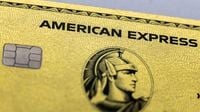On the morning of October 20, 2025, Wall Street woke up to a wave of optimism as US stock futures climbed. The Dow Jones Industrial Average futures ticked up by 0.2%, while the S&P 500 and Nasdaq 100 futures rose by 0.3% and 0.4% respectively, according to reporting from Yahoo Finance. But beneath this upbeat market mood, a deeper story was unfolding—one that reveals just how uneven the American economy feels for different groups, and how spending habits and credit card perks are quietly reshaping who pays for what in the United States.
President Trump’s recent remarks that his threatened tariffs on Chinese imports are “not sustainable” injected a dose of relief into financial markets. The administration’s decision to exempt dozens of products from reciprocal tariffs—and hints that even more duties could be removed—helped cool tensions with Beijing. Treasury Secretary Scott Bessent told reporters that relations with China have “de-escalated,” and he expected to meet with Chinese Vice Premier He Lifeng during the week. Investors interpreted these developments as a sign that the threatened 100% additional tariff on Chinese imports, set for November 1, might not actually take effect. This easing of trade anxiety powered stocks higher, with traders betting that the worst of the trade war rhetoric might be behind them, at least for now.
Yet, while the market celebrated, the US government remained at a standstill. The shutdown, now entering its third week, has become a protracted standoff between Democrats and Republicans, primarily over federal healthcare subsidies. Economists warn that if the shutdown drags on, it could dent near-term GDP growth, although most see any slowdown as temporary. The most immediate casualty has been the flow of crucial economic data: the release of inflation and jobs figures, essential for the Federal Reserve’s interest rate decisions, was delayed. However, the Bureau of Labor Statistics is set to release September’s Consumer Price Index on October 24, a report that could prove pivotal for the Fed’s upcoming meeting.
Amidst these political and economic crosscurrents, earnings season is kicking into high gear. Major companies like Netflix, Coca-Cola, Tesla, and Intel are all set to report, giving investors another round of corporate scorecards to digest. But even as Wall Street focuses on profits and policy, a more subtle transformation is happening in the way Americans spend and pay.
Despite widespread feelings of economic gloom, high earners in the US are spending with abandon, especially through premium credit cards loaded with luxury perks. According to a CNN report, both American Express and JPMorgan Chase have rolled out new benefits for their top-tier cards this year. The Amex Platinum Card now boasts a $200 credit for an Oura ring, while the Chase Sapphire Reserve card offers up to $500 in credits for high-end hotels. These perks come at a hefty price: the Platinum Card’s annual fee has climbed to $895, and the Sapphire Reserve now costs $795 per year. For affluent cardholders, these benefits add up to thousands of dollars in savings and exclusive access to airport lounges, concierge services, and more.
But how are these rewards funded? The answer lies in the so-called “swipe fees”—the charges that merchants pay every time a customer uses a credit card. As Brian Riley, director of credit advisory services at Javelin Strategy & Research, explained to CNN, “The US market has the highest of these rates compared to the rest of the world, and that’s what’s used to fund these very rich rewards.” Since the onset of the Covid-19 pandemic, these swipe fees have soared nearly 70%, according to the National Association of Convenience Stores (NACS), citing data from Nilson. Merchants, squeezed by these rising costs, are left with a tough choice: accept lower profits or raise prices for everyone, including those who pay with cash or debit.
Joanna Stavins, principal economist and policy advisor at the Federal Reserve Bank of Boston, found that those who pay with cash and debit effectively “subsidize” credit card users by paying the same prices without reaping the rewards. “It’s definitely high-income consumers who are more likely to benefit,” Stavins noted. This is not just theory—the data backs it up. In September, credit and debit card spending by high-income households grew more than four times faster than low-income households, according to the Bank of America Institute. Nearly half of all US consumer spending now comes from the top 10% of earners, the highest share since at least 1989. And a Federal Reserve survey found that 51% of households making more than $150,000 annually prefer to pay with credit cards, compared to the majority of low- and middle-income households who stick to cash or debit.
This dynamic has set off a debate about fairness and the future of consumer payments. Doug Kantor, general counsel at NACS, put it bluntly: “Credit card companies (are) working to serve the most affluent customers more and more. They try to get (high earners) more rewards at everyone else’s expense by pushing those costs on to everyone.” The trade group has lobbied for legislation to promote competition and allow merchants to choose cheaper payment networks, but despite support from figures like now-Vice President JD Vance, the bill has stalled and appears unlikely to pass soon.
Credit card companies, for their part, defend the current system. A Chase spokesperson told CNN that while the Sapphire Reserve Card is designed for “affluent customers who deeply value travel, dining and experiences,” the company offers a range of cards for different types of customers. American Express, in a statement on its fees page, says it provides “simplified options” for merchants and offers lower rates for some, depending on their business type, transaction amount, and market.
Some experts argue that swipe fees are a necessary cost of doing business in today’s economy. Todd Zywicki, a law professor at George Mason University, has advocated against capping swipe fees, pointing out that the convenience and fraud protection provided by credit cards benefit both merchants and consumers. “They want the benefits of accepting credit cards without bearing the cost,” he said, suggesting that merchants are free to refuse cards if they find the fees too steep.
Yet, research from the International Monetary Fund complicates the picture. The study found that among credit card users, those with high credit scores—including some with lower incomes—reaped the most benefits from rewards cards. High-income consumers with high credit scores gained the most, while high earners with low credit scores actually lost out more than any other group. This suggests that the divide is not just about income, but also about creditworthiness and access to premium products.
As the US economy moves deeper into the fall of 2025, the split between those who benefit from premium credit card perks and those who don’t seems likely to widen further. With swipe fees at historic highs, a government shutdown stalling economic data, and spending by the affluent driving consumer trends, the question of who really pays for America’s rewards culture is front and center. For now, the answer appears to be: just about everyone, one way or another.




